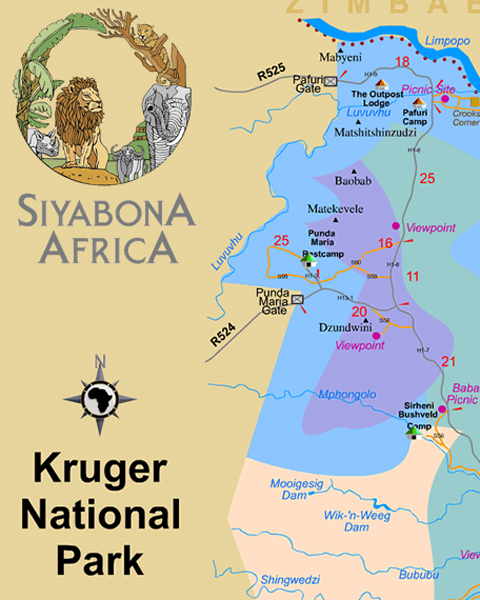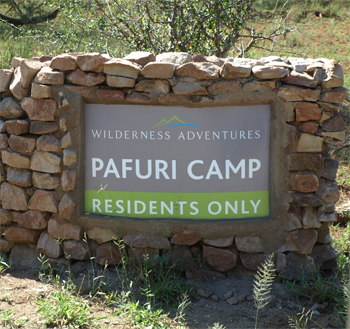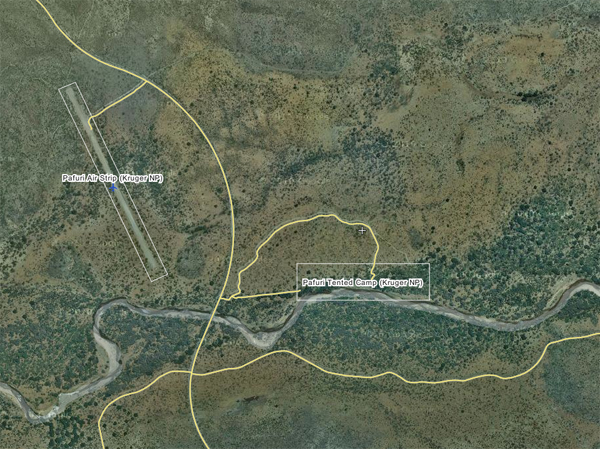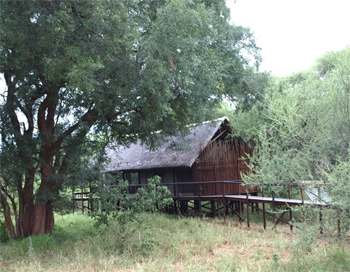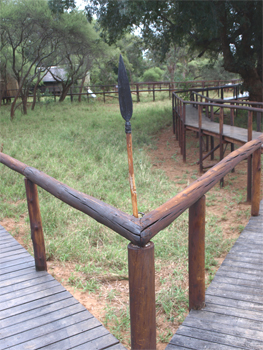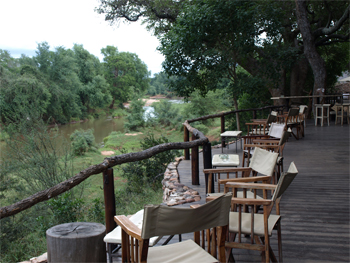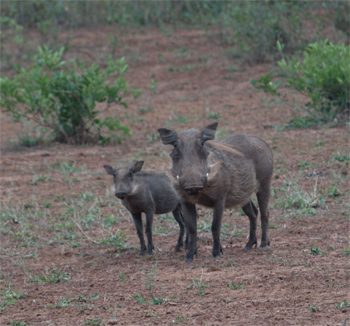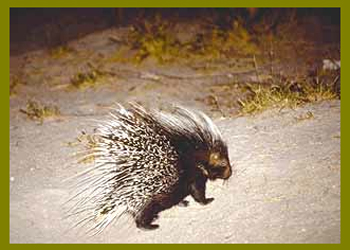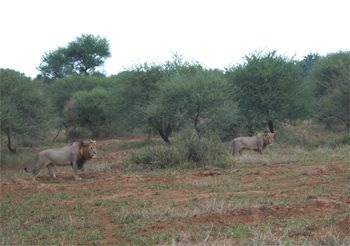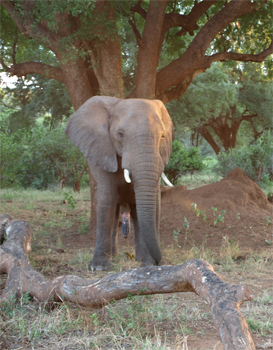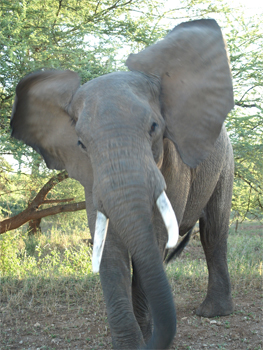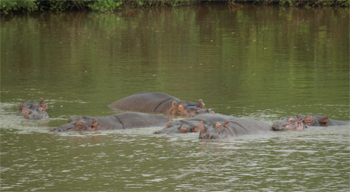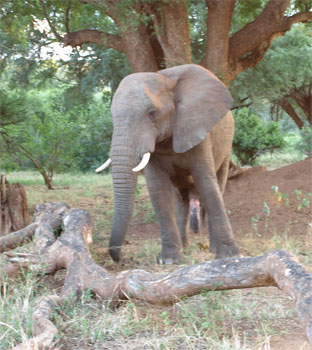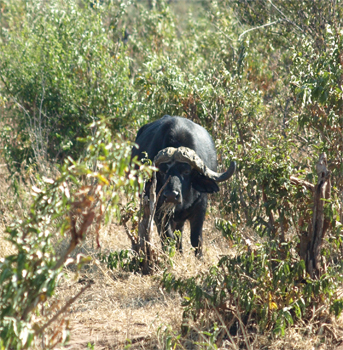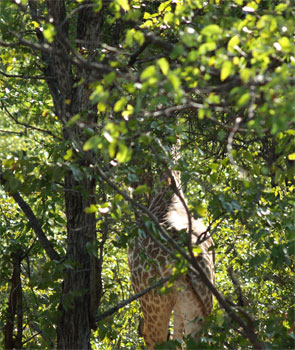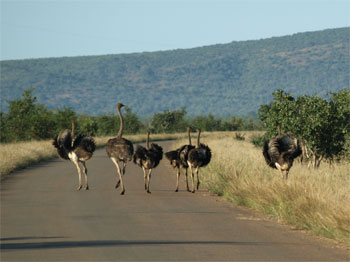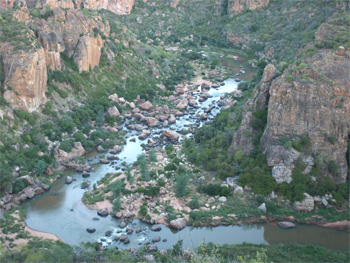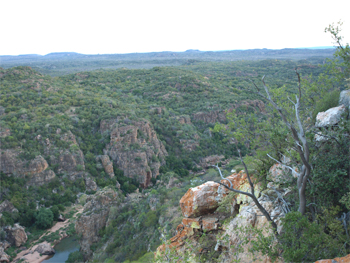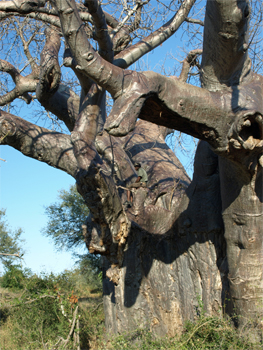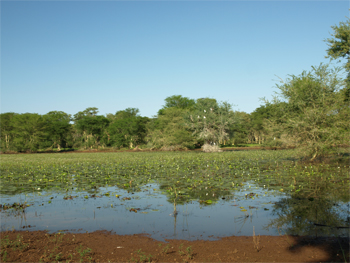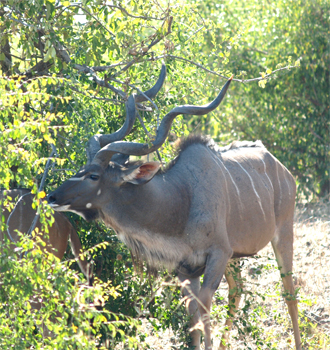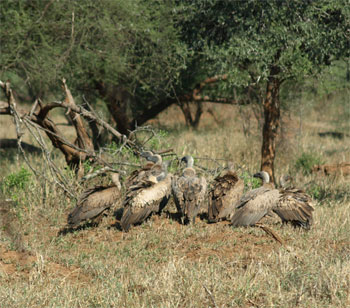May 9-13 - Pafuri Tented Camp, Kruger National Park, South Africa
We were welcomed to camp, given some safety rules about the camp as we enjoyed High Tea (our first food since a very early breakfast on the plane!) of sandwich triangles and fruit juice, dropped our things in our tented suite and headed out for our 3:30 to 7:30 PM game viewing drive. (It is still Monday - no sleep yet!) One of the rules that applied to all of the camps was that after dinner (dark) we had to have an escort back to our living quarters. This is because all of the camps are open to the bush and the animals wander through the camps as they wish. The guides were supposed to be sure no one was lying in wait for us. Meeting an elephant or a hippo on the path is not a good thing!
Pafuri Tented Camp is located within the Makuleke Contract Park, which is an area of private land located between the Limpoppo and Luvuvhu Rivers outside the northern boundary of Kruger NP.
Map of Kruger National Park. Pafuri is designated with a triangle in the upper right corner.
|
|
Entrance sign |
Satellite view showing the landing strip - all dirt
|
Closer satellite view
|
Our happy home. The boardwalks keep us above the animals.
|
Creative way to indicate to the staff that you don't want to be disturbed. Of course, you have to walk half a block on the boardwalk to get to the entrance to put it across the opening.
|
Lodge deck with a view of the Luvuvhu and lots of animals viewing. |
On our first four-hour drive we saw eleven different animals and five spectacular birds and many other common birds. We stopped for "sundowner snacks" at sunset - drinks, trail mix, dried fruit, and jerky.
These were the first animals that we saw - and there were lots of them.
|
|
|
Impalas - these are as numerous as cows in a pasture - they are just all over the place! |
On the way back to camp our driver/guide, Trevor, used a red filtered light to look for the eyes of nocturnal animals in the darkness. We spotted and a huge Giant African Porcupine. The red filter does not temporarily blind the animals the way a spot light would and doesn't leave them vulnerable to predators.
|
Giant African Porcupine (photo from Google - too dark to take my own)
|
As we drove out of camp on the first full day of our stay, we saw two male lions and watched them for quite awhile, marking territory and walking along either side of the dirt road. We saw many more monkeys and baboons in active groups. We also encountered two young (teenage) male elephants that were not real happy to have us on the road. They tried to threaten us with their ears back and trunk down. (Picture an elephant with 5 appendages besides his trunk and you will get the idea!) Trevor had to bang on the jeep body to show them we were dominant. This stopped the one elephant that started after us with attack on his mind.
Our first lions |
|
Seriously attacking
|
|
The afternoon of the first full day at Pafuri, we drove on out to Crooks' Corner at the confluence of the two rivers (Limpopo and Luvuvhu) where three colonies met: South Africa, Britain's Rhodesia (today's Zimbabwe), and Portuguese East Africa (Mozambique). Legend refers to the area as Crooks' Corner because outlaws could simply cross the river - to their country of choice - to escape a colonial power. We did not see outlaws, but did see a raft of happy hippos standing in the water. They occasionally snorted out water or opened their huge mouths. They were not interested in us or in posing for pictures.
On the way back to camp we encountered another young elephant bull, which was busy scratching his hide on a tree and blocking the road. He was not anxious to move away and we had no detour available. After the lengthy stand off, he moved a few meters and we were able to get through.
Happy Hippos
|
|
This evening (too dark for photos) we spotted our first leopard with the help of the red filter spotlight. He was walking in front of us, turning his tail to various bushes and leaving his scent. It is a way of advertizing to females, that there is a sexy male in this area and to other males that this is his territory. Just as we were about to enter our camp entrance, a lion appeared on our road, then a hippo crossed in front of us and another huge lion sprawled across the paved road completely blocking access. It was interesting to watch the hippo maneuver on land. He was rather agile for such a whale-like animal.
The second night's dinner was a traditional Makuleke meal served outdoors in the Boma or Kraal - a circular meeting place. The appetizer was a heated ruffle potato chip with a chunk of tuna and parsley (a nice taste combination), minestrone soup, salad, and a combination of buffet dishes. I tried polenta (white corn mush which I later discovered was a common replacement for mashed potatoes on our dinner buffets), oxtail soup, a spicy chicken stew, a veggie stew, and a traditional beef sausage. Some things were spicy, some bland (polenta, for example), but all quite palatable. Dessert was a type of pudding with chocolate sauce. We ate by candlelight and afterwards had to be escorted to our tents as our guide looked around for any unwanted animals.
Next morning we headed south through Kruger NP to look for Cape Buffalo and Giraffes. The landscape changed to a broad flat savannah of grass and shrub bushes. We saw a family of Ostriches - male, female, and several young ones. We watched them for a while. We were afraid we would be skunked trying to find a giraffe (which would have made our guide Trevor feel like a failure), but Gale finally spotted one in the trees maybe 5 yards off the road. It turned out to be a large male and a young one. They were very curious and stared at us as we stared at them. They were fun to watch.
On the way back we saw a Cape Grysbok, which is a small antelope and a bunch of Cape Buffalos. They are very large and nasty looking up close. We saw two Kori Bustards, which are the heaviest birds that can fly. They weigh 26 to 28 pounds.
Cape Buffalo
|
First Giraffe |
Ostriches |
Kori Bustards
|
After tea, we rode out to Lanner Gorge to look for white rhinos. We did not find any of the 4 or 5 who inhabit the thick brush and rocky terrain we drove through. Our Toyota jeep struggled through some really rough rocky paths and sand, but we did not see any rhinos. At one viewpoint the colorful Bee-eater birds were congregating, flying as a group to catch insects over the river and then sitting along a branch. They beat the insect on the branch to kill it and then swallow it. Bee-eaters are colorful and pretty. We also saw Crested Barbets and Helmeted Guinea Fowl.
At the Lanner Gorge we hiked/scrambled up a rocky trail and looked way down into the gorge at the river, which cut through the lava and sedimentary rock eons ago. It was a spectacular view to look out on. Almost back at camp, we had about 40 or 50 Cape buffalo cross the road ahead of us. Good thing we weren't in the middle of them!
Lanner Gorge
|
Lanner Gorge |
Last day at Pafuri. This morning Trevor woke us up a little earlier and gave us an astronomy lesson. At 5:30 AM, four planets - Venus, Jupiter, Mercury, and Mars were all visible in the eastern sky. Scorpio was just setting and we could see many of the stars in its tail. Marge and I also saw a satellite move across the southern sky. The sky at all of the camps is jet black - no ambient light at all - and you can see so many stars that it is difficult to pick out specific constellations. Itmakes you want to just keep looking up. Almost every evening as we returned from game drives, we would watch for the Southern Cross to emerge, Orion to set, and Scorpio to rise. Beautiful!
Four planet alignment (photo from Google)
|
|
After croissants and coffee we drove out to see the oldest baobab tree in Kruger. On the way we took a closer look at some other trees.
The next stop was at a beautiful large lily pond filled with water lilies. These lilies have edible fruit and roots. Many varieties of birds were gathered around the pond. Some that we could name were: great egrets, grey heron, cormorant, spoonbills, one Egyptian goose, spare wing goose, storks, and plovers. Across the pond was a stand of fever tree acacias, which complete photosynthesis in their bark. As a result, elephants like to strip the bark. It is a good thing these trees are fast growing. At the pond edge of the fever trees was the first eland that we saw. It was so active, peaceful, and beautiful that we stayed there for snacks (cocoa and cookies) and weren't in a hurry to leave.
|
|
Lily Pond
|
Egrets and Cormorants
|
On the way back to camp we watched some very large kudus. They have a hump on their spine to identify them from nyalas. The males have impressive twisted horns.
|
|
|
White-backed Vultures |
After this final game drive, we went back to camp, cleaned up and packed, ate brunch, and headed for the airstrip. Our plane arrived at 12:45 with the next OAT tour group who will follow two days behind us. This is a very popular tour! Trevor and another safari guide had to stand watch over the airstrip and chase zebras and impalas off of it for the plane to land and takeoff.
We flew 1 hour and 45 minutes back to Joburg and then had a minivan ride for another 1 3/4 hours to our hotel near the international airport. We checked in, did some laundry, rested, had dinner in the hotel restaurant and were in bed by 9:30. The hotel had a unique airplane motif.
The Pafuri safari camp was top class and more like a 5 star hotel than a camp. Our tent had two large single beds with mosquito nets hanging over them at night, a writing table and chair, a soft chair, two chairs and a bench out on the veranda, and a nice shower and bathroom. The walls were canvas and screens, it was raised above ground, and the floor was cement with rugs. There was a boardwalk from the open-air lounge and dining room area to each of our separate "tents." The walkway was high enough for smaller animals to go underneath and there were occasional ramps down to the ground for a large animal crossing area. There were several animals around the tents all the time. Nothing was enclosed so the animals go where they want - which is why we had to be watchful and have an escort at night.
Our trip to Pafuri Camp and Kruger NP will be tough act to follow at our next safari camps.
| Return to Top | Return to Itinerary | Return to Dreamcatcher Home Page |
